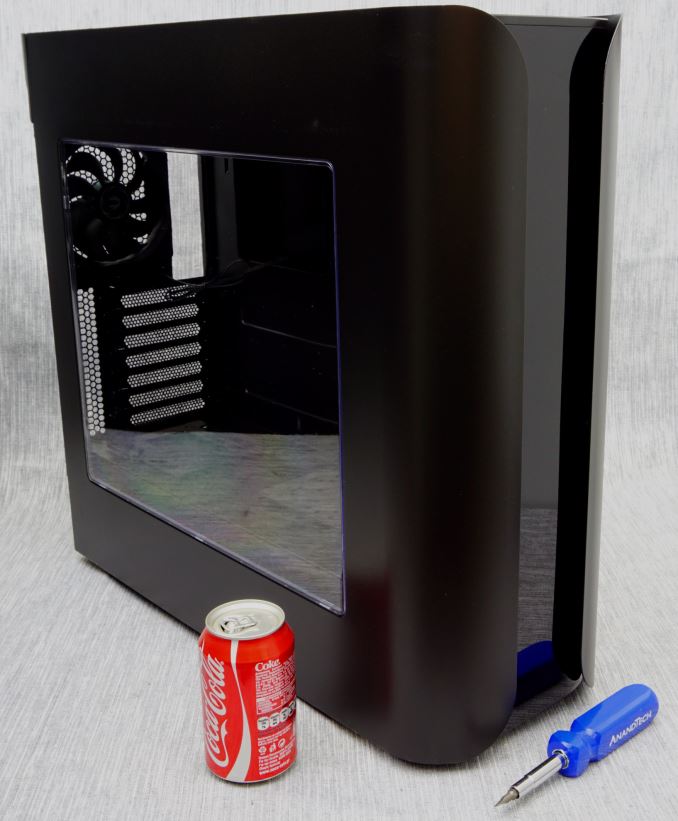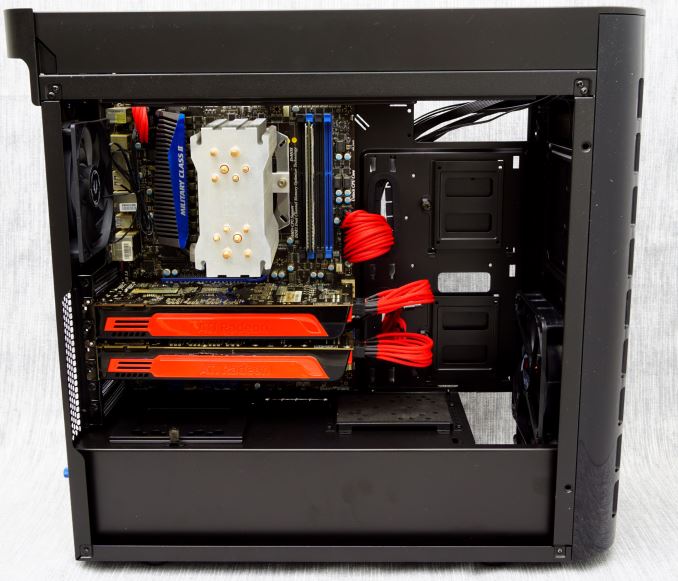The BitFenix Pandora ATX Case Review
by E. Fylladitakis on August 11, 2016 9:00 AM EST- Posted in
- Cases/Cooling/PSUs
- bitfenix
- ATX
- Case
Conclusion
Even though the Pandora ATX is aesthetically based on the original Micro-ATX version of the Pandora, any similarities between the two cases are limited to just their aesthetic design. Where the original version was meant for users who would like a beautiful case for a relatively strong but mainstream PC, the Pandora ATX is directed towards a completely different target group. The size, design, versatility and emphasis on liquid cooling support of the Pandora ATX dictate that it has been designed for users that will be installing very powerful and quite possibly overclocked hardware. The target group that the Pandora ATX is aimed to is very demanding and difficult to please. Even the smallest detail can affect the buyer’s decision and the Pandora ATX is definitely not without flaws.
The primary selling point of the Pandora ATX undoubtedly is, aesthetically speaking, its design. Aesthetics are a subjective matter but it is no secret that the original Pandora was a case loved by modders and users that would place their systems in areas that would make them visible by their friends or guests (e.g. living rooms). It is obvious that BitFenix is trying to replicate this success with the Pandora ATX for users that did not like the limitations of a Micro-ATX build. However, the size of the Pandora ATX is restrictive, as a case this size would look out of place in a simple, modern living room. On the other hand, the roomy case can house powerful hardware and advanced liquid cooling systems, making it ideal for advanced modders and liquid cooling aficionados that want to showcase their work or for large VR systems.
BitFenix tried their best to make the Pandora ATX a versatile case, easing up the work of modders and especially those that plan to install advanced liquid cooling parts. The capability to interchange the front 2.5” and 3.5” trays is interesting, as is the presence of liquid cooling tank and pump supports. The vast majority of commercial liquid cooling parts should be compatible with the Pandora ATX, from large 360 mm radiators to high pressure 12V pumps. The position of the pump mount however creates compatibility issues, as it would most likely block the installation of even a second advanced GPU. It is very strange why the designer did not place this mount down inside the PSU compartment area, where the 3.5” drive trays have been placed. This would limit the number of 3.5” drives, reducing them by at least two, but the pump would stay out of the way of the GPU cards. Those that will be installing more than one GPU will most likely be modifying the case so as to move the pump inside the bottom compartment. Finally, tanks that have been designed for installation in 5.25” device slots obviously are incompatible, as the Pandora ATX does not support 5.25” devices.
The build quality of the Pandora ATX has left us with mixed feelings. It is not uncommon to see cases with mediocre panels on a good chassis or with simple, low quality stock cooling fans installed when designers are trying to cut down the manufacturing costs. In this instance however, it seems as if the designer of the Pandora ATX worked the other way around. The front panel and plastics of the case are of excellent quality and very high quality FDB bearing cooling fans have been installed, whereas the chassis and side panels are relatively thin and weak for a case of this size. It is likely that BitFenix is using the same materials and thickness as with the original Pandora, which was significantly smaller and lighter. The result is a rather malleable chassis that could face permanent damage if mishandled with heavy hardware installed into it and side panels that are susceptible to dents, especially on the flaps extending in front of the case.
In our opinion, the greatest advantage of the Pandora ATX against the competition is its retail price. The case can be found for $112 including shipping at the time of this review, a very fair price for its size, versatility and features. There are few cases of this size at this price point where the designer emphasises on aesthetics and, at the same time, provides exceptional support for advanced liquid cooling setups. We feel that the Pandora ATX will become a favourite among enthusiasts that are building powerful, liquid cooled gaming systems and want to create an aesthetically pleasing result with relatively low effort and custom modifications.












26 Comments
View All Comments
SimonJM - Friday, August 12, 2016 - link
The display would've looked better if it was OLED. The non-black background of the screen doesn't blend so well with the black case.Jackattak - Friday, August 12, 2016 - link
A reset button? In 2016? Seriously?HomeworldFound - Friday, August 12, 2016 - link
Yes, Many cases still have one of those. If you've tried feature games from the Windows 10 Store you'll be so happy to own one.pedjache - Saturday, August 13, 2016 - link
You seriously need a reset.pauliem30 - Sunday, August 14, 2016 - link
I just got this case the other day to do a review on. I'm very excited to do the build in it!ES_Revenge - Tuesday, August 16, 2016 - link
I have an original [mATX] Pandora. While I like the case, I always wondered why the thing is so tall for an mATX case that doesn't really seem like it needs to be as tall as it is. It seems as though they could have just made it slightly taller and allowed an ODD somehow (which I know no one cares about anymore but at the time it still sort of made sense). Even if they could have incorporated a slot and allowed a vertical slim/slot ODD it would have been cool.Well now it seems they have just gone ahead and made the case even taller, but to fit a full ATX motherboard instead. I dunno I don't see the point. There's lots of competent mATX boards out there these days and have been for quite some time. Vast majority of ppl I see with full ATX boards these days have like one or two slots used and then 5-6 ones sitting there doing nothing. ATX just seems passe these days. There's even mATX cases that support SLI and mATX cases that have a "fifth slot" opening (which the original Pandora itself has), in case you have your second GPU slot at the end of the board. With all that the Pandora full ATX seems a bit pointless.
Personally I didn't get the one with the display at the time because it was ~$50 more and it didn't seem worth it because the display is not capable of much. Fast forward a few years and it seems functionality hasn't improved at all. Basically just still a static display with little use. I know they released the source code or whatever so ppl could do whatever with it, but it seems like no one has. I always used to think a cool application would be to display album art, which would automatically change with whatever track you were listening to. Surely they could have a plug-in for programs like MediaMonkey, etc. which could accomplish this. Instead it seems the use of the display is still very limited and all they bothered to do was make the case bigger. The display has even made it on to cases like the Aegis but again other than it's appearance and $30-50 premium over the "core" case without it, it's not really something of that much use. Looks cool for a day and then you forget about it.